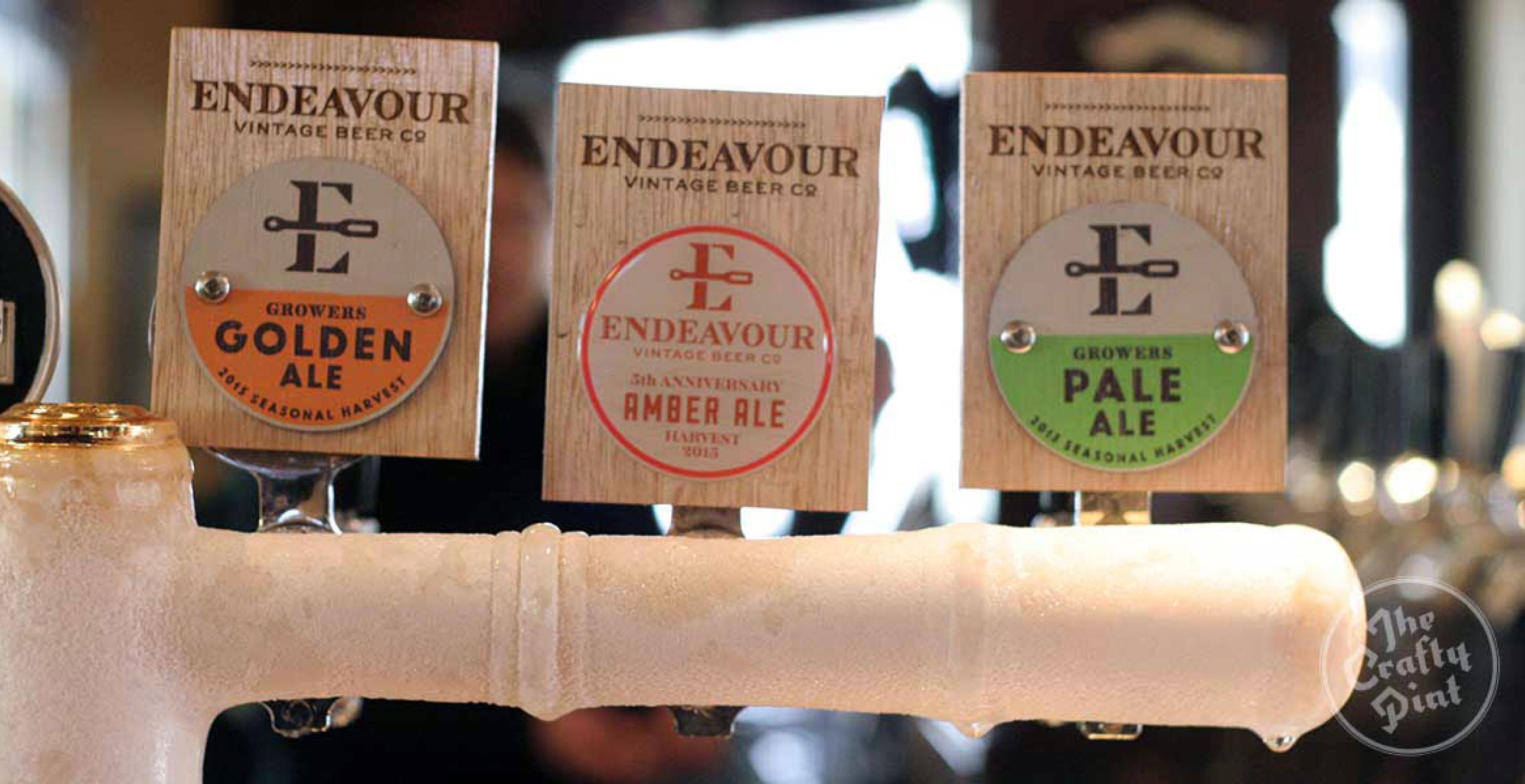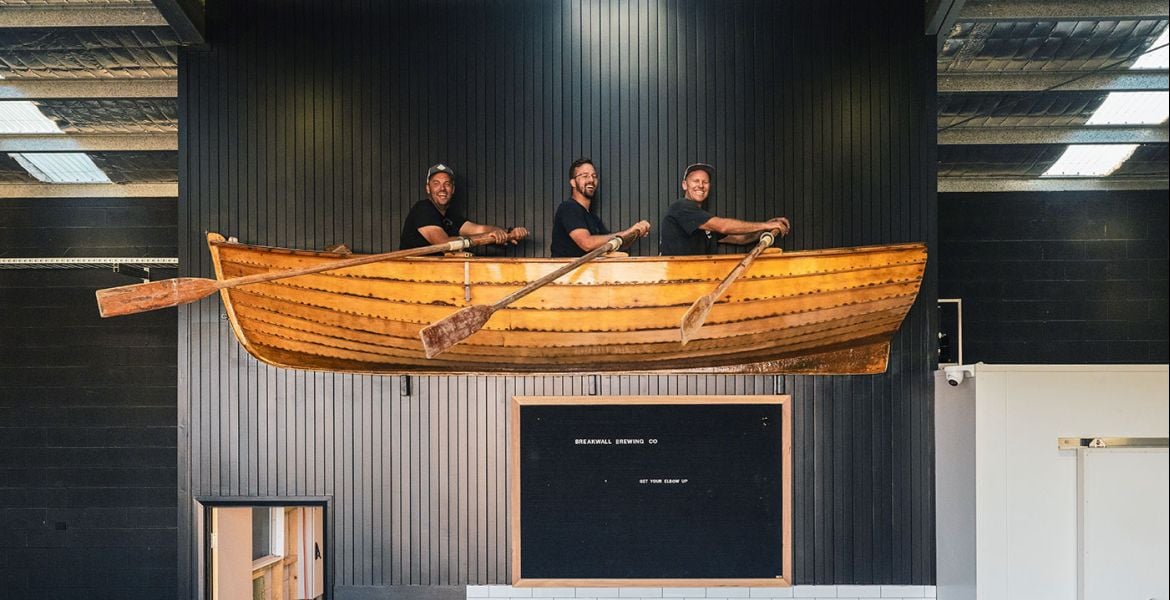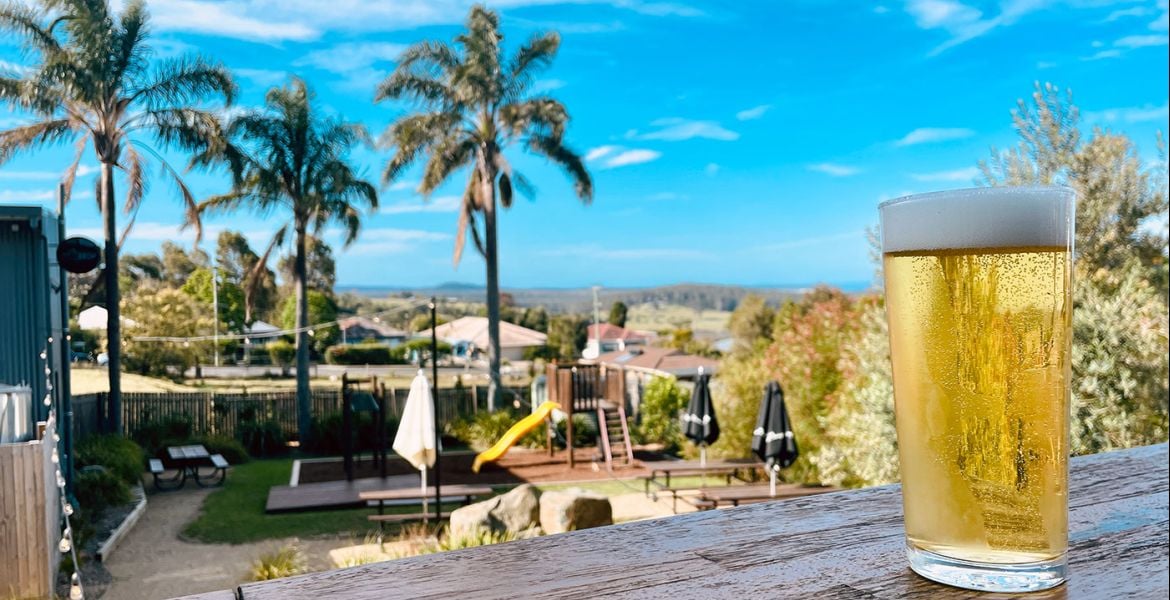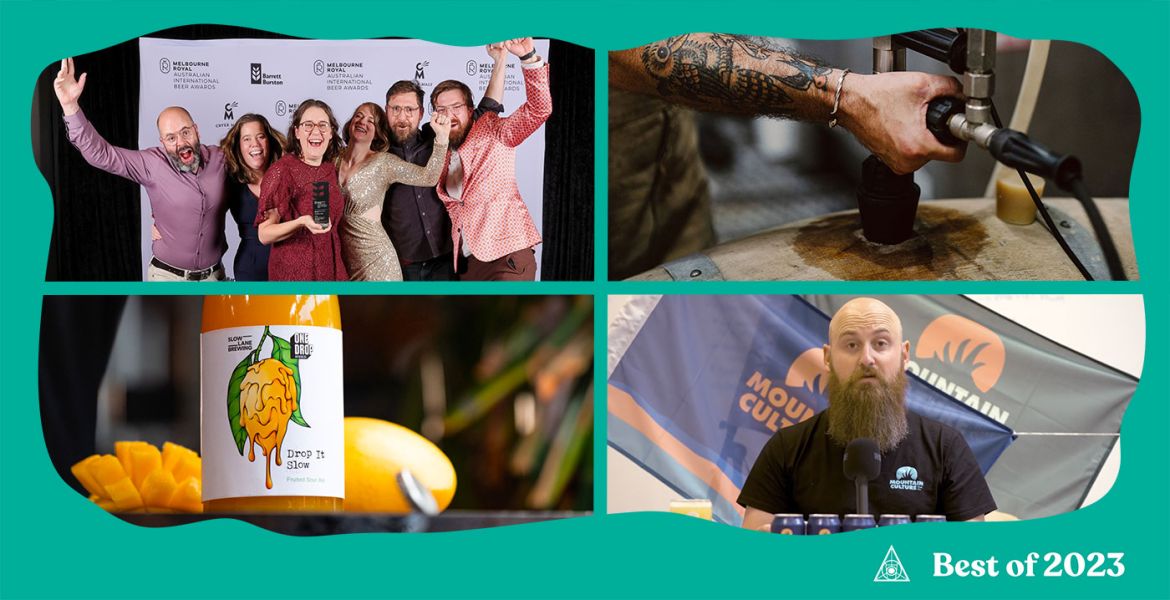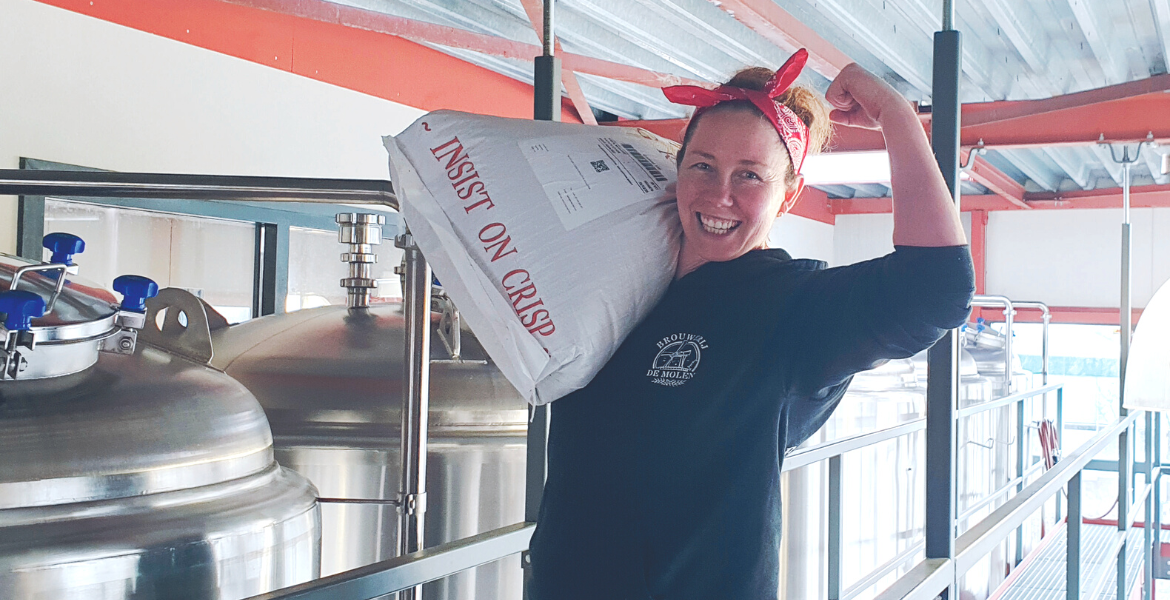There’s an old adage that wine is made in the vineyard. It’s a line that neatly captures wine’s sense of place and romance while also acknowledging its more literal agrarian roots: the vine is planted in the soil, water nourishes it, the sun provides energy to grow, the fruit is born and harvested. Wine can thus be viewed as the culmination of an agricultural process, one whose ultimate quality is directly impacted by the conditions in which its ingredients were grown. Different measures of rain, sun, frost, wind, pests or any number of other things will affect the final product immeasurably.
For the past five years, the Endeavour Beer Company has been filtering its beer through a similar narrative. Set up in Sydney by Ben Kooyman, Andy Stewart and Dan Hastings, Endeavour is what they termed a "True Vintage Beer Company". What that vintage label meant was producing beers using only ingredients harvested within the same year as opposed to vintage in the way people might view Coopers Vintage: a beer brewed with different ingredients each year that more openly embraces the idea of cellaring.
As with the vine to wine concept, the idea was to allow for and showcase seasonal variation within beer’s core agricultural components: malt and hops. Of course, most brewers – for the vast majority of their beers – ask for the freshest hops and malt they can obtain and would be loath to use ingredients from previous year's crops but, unlike Endeavour's modus operandi, they then try to use those ingredients to produce beers that vary little from batch to batch or year to year. Equally, while it is becoming increasingly common for brewers to visit the farms producing their ingredients at harvest time, few make it so central to their narrative.
That said, Endeavour's narrative is one that would seem a snug fit with today’s engaged consumer, for whom associated factors like freshness and provenance – not just with respect to beer, but most any digestible item – is a compelling selling point. But when they first appeared on the market, Endeavour’s tales of origins and ingredients weren’t necessarily welcomed with a warm embrace.
“When we first tried to do True Vintage Beer,” recalls Ben, “we definitely copped stick for putting that on our labels.
“We were constantly asked, ‘What’s vintage about your beers? They won’t age well.’ So it was usually a case of us having to say, ’OK, if you consider vintage as ageing then, no, ours aren't your typical vintage beers.'”
That caveat meant it wasn’t necessarily the most straightforward story to tell a drinker. In conversation, perhaps, but when read straight off a label you could understand how a sceptical drinker might view it as less story, more marketing spin. Adding to the murk, and even the irk, was the fact that Endeavour don’t own their own brewery.
“When we started,” says Ben, “contract or gypsy brewing was really frowned upon. They were massive dirty words.”
The perception problem attached to contract brewing often boils down to whether a beer is actually what it seems.
Should you wish to launch your own beer brand it’s a relatively straightforward, albeit slightly costly, process to contract the services of a production brewer and have them create you, say, a thousand cases of beer. You could then engage a marketing company to come up with a compelling backstory, a designer to whip up a nice label and a PR company to take care of the promotion. In a short space of time, your new brand could be sitting on shelves alongside the most famous names in beer. Meanwhile, the average consumer buying that beer may have no idea of the truth behind the label.
An extreme example no doubt, and by no means an approach that Endeavour followed, but it’s into that realm, with its occasional dodgy dealer, lack of transparency and stigma, where they found themselves operating. To their credit, Endeavour never concealed the fact that they were outsourcing their production and were understandably keen to disassociate themselves from any half-truths.
“There are different levels of outsourcing,” says Ben. “There’s contract where someone walks into a brewery and says, ‘I want a pale ale. What are your recipes? What are your label options? Tell me when it’s ready to pick up.’ Then there are those that are quite hands-on, which is the level we’re at, to the point where we’re visiting farmers a couple of times a year.”
In the time since Endeavour set forth, attitudes toward contract brewing have softened considerably in Australia. There’s now far more acceptance of the positive part it can play in the industry, such as fulfilling the extra capacity demands of smaller brewers or providing packaging options at a level of quality many small brewers can’t match or afford in-house. Between them, contract and gypsy brewing as a way to enter the market has become common almost to the point of convention and some of the country’s most talked about craft beers are made by one brewer in someone else's brewery.
“Nowadays,” says Ben, “you actually have guys championing contract brewing and people outsourcing or expanding into other facilities that you never thought would. The industry has certainly changed a lot in the last five years.”

It was in 2007, three years before they would produce any beer, that Ben (above left with Andy) first planted the seed of what would become Endeavour.
“I was working at a wine and spirits company and I’d had a shit week,” he says. “I’d had my beer epiphany in the USA way back in 1999 but in Sydney it was still hard to get good, flavoursome beer so I hit up Andy and Dan saying, ‘You know, I’ve got this idea…’
“I was fortunate to have the chance to do a business plan for some study which got me talking to people like Nick Button and Bruce Peachey at AIB (Australian Independent Brewers) and the guys at HPA (Hop Products Australia) about different crops. I completed the business plan, rang a couple of old customers and said I wanted to show them something. They basically said, ‘We’ll take it’, so I rang Andy and Dan and said, ‘We’re starting that beer company!’"
With their respective backgrounds – Ben in sales and marketing, Andy in operations, logistics and farming (all with a wine focus) and Dan in finance – between them they had what Andy calls “the pillars of business”. But there was one important thing they didn’t have: enough money. The solution was found with a little help from their friends.
Says Ben: “We got a few mates around to a pub in North Sydney, showed them the concept, that we had customers ready to order, and we raised just enough money to add to our own and get some beer out the door.
“We were dealing with AIB so had to figure out how to do two runs: a Reserve Pale Ale and Reserve Amber. Andy worked with Nick and Bruce to crack the recipes and he nailed them – actually, we shat ourselves for the first few days because they’re bottle conditioned and that sort of beer isn’t great off the line, but it hit its straps and a couple of weeks later it was drinking well.”
The first release was the pale ale and Ben’s recollection of how that beer was received offers something of a marker of how consumer beer tastes have changed.
“That pale ale was quite an easy drinking beer but everyone at the time was saying how fruity it was. Stone & Wood had launched their Draught Ale [later to become Pacific Ale] and while it wasn’t as fruity as that, everyone we tested it with said, ‘Wow, it’s really fruity!’. Since then it’s gone from using two hops to three hops and now the 2015 will be dry hopped for the first time. So we’ve gone from five years ago people saying our pale was too fruity or hoppy to now saying, ‘We want more hops.’ It’s an evolution of the consumer and palate preferences.”
With their vintage approach, Endeavour was set up to evolve too.
Most brewers will establish themselves with a core range of beers based on proven recipes. Each time one of those beers is brewed, the objective is consistency so that drinkers experience as little discernible difference as possible between batches. Replicating a recipe isn’t always as straightforward as adding the same ingredients, using the same method and having the beer turn out exactly the same. Brewers often have to tinker with things to achieve the desired outcome. Sometimes there can be significant variations to contend with; batches of malt might be different, the usual hops might not be available or ingredients might be sourced from a different supplier. Whatever the case, it’s up to the brewer to shoehorn everything towards that set outcome.
Where Endeavour’s vintage approach differs slightly is by letting the harvest have more say in how they build a beer. So while they will always have, say, an amber ale in their core range, this years will be different to the last depending on how the growing conditions have affected the character of the hops and malt. This makes Endeavour a rarity: a brewing company whose entire core range intentionally changes each year. It’s an approach that has its ups and downs.
Says Andy: “Some of the worst agricultural years have produced some of our most successful beers. The 2011 pale ale won a medal at the World Beer Cup and that was off a bad barley harvest [due to a wet growing season]. But that in itself took two brews to get right. The first one was a shocker and for the second one we thought, ‘OK, this is how we’ll have to deal with it’, and it got second at the World Beer Cup as an international pale ale. The thing is, we can’t put that on labels because a few months later we change the recipes. People think we’re crazy.”
Why then, have they stuck steadfastly to such an approach?
“We were all wine guys,” says Ben, “and the most exciting part of wine, I think, is the viticultural aspect of it.”
Says Andy: “No one in the industry at that time was really engaging with the farmers about the raw ingredients going into the end product. One of the most exciting parts was talking to these farmers and they’re going, ‘Wow, that’s really cool – you’re going to showcase what we do as well.’
“I think people want the depth of knowledge about the product. They like the idea that when you buy a steak, even from the likes of Coles or Woolworths, that it’s grass fed from Inverell. There’s an affinity with the farmer that makes them feel good about what they’re buying. That’s not the reason we did it – our reason was basically to push what we thought we could do conceptually with differences in ingredients year after year.
“What we’re essentially trying to do is tell people that beer doesn’t start in a factory. There’s a lot of craftsmanship in a brewery, obviously, and you can turn good ingredients into bad beer, but you can't turn bad ingredients into good beer.”
Adds Ben: “We don’t think vintage beers are going to take over the world but we certainly think there’s a place for them. We love seeing what’s coming out of the fields, having a crack at new hops and that our beers change every year.”
It’s been long, slow, steady process to try and get their message through to people but after five years they’re confident they’re on the right path, one that, at some point soon, should lead to their own brewery.
“Five years in and we’re going OK as a wholesale beer business,” says Ben, “but we want that home.
“We’re on a crusade to find the right site for a brewery, kitchen and bar but it’s a long process. We’ve been trying for about two years and made offers on four sites so far but for one reason or another they’ve fallen over. We’re Sydney boys so we want a home here, but you’re picking one of the toughest markets to find a commercial space. Then there’s the bureaucracy: loading zones, head heights, exhausts, waste water – all the places we’ve looked at have been exciting opportunities but all have had hurdles. And they’re all bloody expensive!”
“The other dream is a beer estate in Tasmania, close to the action of the barley and hop fields, to showcase what one bit of ground can do for a beer [à la Two Metre Tall and Van Dieman], but that’ll be a few years after we get a brewhouse set up.”
While they continue to keep one eye fixed on the property pages, the other has been cast towards opportunities beyond the horizon.
“In the past 12 months we’ve explored new markets like Hong Kong and we’re looking elsewhere into Asia,” says Ben. “We sent a fairly decent shipment and it all seems to be going very well. Australia, on a global scale, is such a small market but if you can do well here given the amount of competition I think you can take the model elsewhere.
“Australia’s also got a great reputation for produce so it’s a chance for us to reflect that story of the farm to the glass, rather than just the brewery to the glass. It can be a hard story to tell, but we’ll keep cracking on with it.”
Five years in, you can’t help but think they will, making small adjustments to try to clear up that old contretemps about vintage as a year versus vintage as it applies to ageing.
“We’re still a vintage beer company,” says Ben, “but we find we’re using ‘harvest’ more and more. And we do think our amber ale ages pretty well. Not for twenty years, but for two or three years it does.
“We’re not the craftiest guys out there and never pretended to be. We make traditional styles and we try to brew them well. The vintage aspect is the most unusual thing we do. I don’t think it’s about being mainstream, but about making a good, balanced product that people like drinking. The seasonal beers give us the opportunity to make things a little bit different or eclectic and focus on hops or grain or whatever, but the rest of the time we’re just focused on making consistent beers.”

Endeavour Brew & A
As one of longest-running brewing companies in Australia still solely contract brewing, the Endeavour guys are, in their own way, elder statesmen of the game. With so many contract and gypsy brewers joining the fray in recent years and many more on the verge, we asked Ben and Andy to share a few tips with those thinking of heading down a similar path…
ON BEING OPEN…
Andy: “Don’t bullshit anyone. We’ve always said we’ve used a contract facility. Some people say, ‘We only ever brew our own stuff here or there' and you know full well they’re not because they don’t have a bottling line yet they have bottled product.”
ON BUSINESS BEYOND BREWING…
Ben: “When we stared there were around 160 beer companies in Australia and a lot of that was very regional; for example, you didn’t really see Mountain Goat in Sydney. There’d have to be twice as many brands out there now as when we started and everyone’s expanded their portfolio. We started with two beers, now we’ve got six. It’s exploded. If we looked at the industry today, five years ago, we might’ve said, ‘Whoa, how the hell are we going to survive that?’”
Andy: “You have to marry up some business acumen with the passion. Ben comes from a sales background, I come from an operations, logistics and farming background and Dan is from a finance background. That acumen was inbuilt. You can make the best beer in the world but it doesn’t mean you’re going to survive past the first six months if you haven’t created your business correctly.
“From my point of view, if we didn’t have Ben we’d be in trouble, if we didn’t have Dan we’d be in trouble and I hope they’d say the same thing about me! We’re all pretty crucial parts of the mix and we stick to what we do best to ensure we survive. I think that first five years is about survival. By that stage you become part of the industry, part of the noise, and after that growth is a bit exponential.”
ON NOT HAVING A BREWERY: THE PROS AND CONS…
Andy: “One week it’s good, one week it’s not. The fact we can use someone else’s kit gives us some flexibility, but also constraints. You can’t necessarily call them and say, ‘We want to come out and brew some amber ale tomorrow’ because they’re not going to have space. It makes you pretty well planned, but at the same time, if we have a really good month on pale ale kegs and we want to take or volume from, say, 100 hectolitres to 300 hectolitres in a short space of time, we can do that. When you have your own facility you might lose a bit of that flexibility.
“The packing side of the business delivers a certain amount of quality that you can’t always get on small systems. That’s always been my biggest worry about own own facility. If you’re doing kegs you can be any size but as soon as you start talking about packaging, you need to reach a certain size before you can possibly justify putting a packing line in. So I think that’s given us flexibility to invest that money elsewhere like sales and getting broader reach.”
ON BEING INVOLVED…
Andy: “You have to understand the manufacturing side of things. There are ups and downs of manufacturing no matter what you’re making. It doesn’t just happen so you’ve got to do your homework and be intimately involved with the guys that own the facility.
“The guys we work with, we’re really engaged with. We’ve never gone to the really big contract facilities and said, ‘We want you to brew our pale ale, go for it.’ We’ve built good relationships, been really engaged with the guys [running the the breweries] and made sure that what we’re doing in their facilities is important to them.
“Don’t just send a purchase order and expect them to call you when it’s ready. It’s a passion game and we’re as engaged with the guys as we can be. At the end of the day, if we spend a few weeks brewing the beer and it comes out like shit, there are no winners there.
Ben: “It’s much easier if you get along with the guys you’re working with. For example, if the filter breaks, or something breaks, and they don’t really care about you, they mightn’t be in any hurry to fix it. But if something breaks and they think, ‘Man, we need to get this fixed for the guys’, chances are it’ll get fixed sooner.
ON SALES…
Andy: “Forecasting is crucial. It’s that business acumen thing. It’s not like you can run out of beer on Wednesday then have it coming out the tap again the day after. You’ve really got to be on the front foot because not only have you got to be looking after your sales schedule, you’ve got to fit in with someone else’s brewing schedule.”
Ben: “From a sales and marketing perspective I’d say you got to pick your market and be true to it. You see a lot of guys coming out who seem, on the face of it, to be very similar to what else is out there already and we’ve seen the dangers of that in the wine industry. A Barossa shiraz that’s not interesting is just another Barossa shiraz. That kind of thing can only lead to a downward spiral in price.”
ON RETAIL OPPORTUNITIES…
Ben: “I don’t think people talk enough about the bottled sales. A lot of the smaller guys are only in kegs because of the infrastructure, whereas we’ve always been heavily into bottles. We probably look at the retail landscape a lot more than some of our peers. The interesting thing is that, except in some of the big independent chains, there aren’t contracts on fridges. I’m sure there are commercial deals done but the big chains have actually helped the craft industry grow because they’ve given us a fair amount of shelf space compared to the runs we have on the board.”
Andy: “Our shelf presence isn’t commensurate with the volume. They’ll give us facings even though we don’t sell like Fat Yak does, but they want us in there for variety. There’s a lot of talk about taps and tap contracts, but the small guys have a decent opportunity to have a go in the retail space. It’s something that’s not really talked about. If you’ve got a good product that stacks up commercially for the retailer, which it has to – they’re not going to give you a free kick, they want benefit too – then there are opportunities.”
ON BEING REALISTIC…
Ben: “It’s a lot of hard work. I went in with rose tinted glasses and we’re lucky all our friends and family have been patient. We’re on the trajectory we thought we’d be, but it’s just a bit slower.
"We’re not in it to make gazillions of dollars because if we were we’d have invested in something else. Beer’s not the place to make millions – there’s maybe one story like that in a thousand. It’s not like there’s a big acquisition in beer every week – there isn’t even one a year at the moment and you see a lot of the long term brands are suffering declines so what’s to say some of the small brands won’t thrive? A lot of boats are coming in with the rising tide and some will probably go out with the falling tide. However, the scene is the best it’s ever been and it’s only going to get better.”



